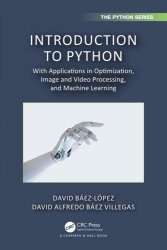 Название: Introduction to Python: With Applications in Optimization, Image and Video Processing, and Machine Learning
Название: Introduction to Python: With Applications in Optimization, Image and Video Processing, and Machine LearningАвтор: David Báez-López, David Alfredo Báez Villegas
Издательство: CRC Press
Серия: The Python Series
Год: 2024
Страниц: 453
Язык: английский
Формат: pdf (true), epub
Размер: 11.1 MB
Introduction to Python: with Applications in Optimization, Image and Video Processing, and Machine Learning is intended primarily for advanced undergraduate and graduate students in quantitative sciences such as mathematics, Computer Science, and engineering. In addition to this, the book is written in such a way that it can also serve as a self-contained handbook for professionals working in quantitative fields including finance, IT, and many other industries where programming is a useful or essential tool.
The book is written to be accessible and useful to those with no prior experience of Python, but those who are somewhat more adept will also benefit from the more advanced material that comes later in the book.
This book was born from a programming course taught at Universidad de las Americas-Puebla, Mexico. In that time, Python was gaining strength as a powerful programming language, but nobody foresaw that it could become one of the most used programming languages. In fact, the TIOBE index ranks Python as the most used programming language in the world. This fact is due to the characteristics it possesses. Python is a high-level programming language that supports procedural, imperative, object-oriented, and functional modes. This book covers the first three modes. Python has a simple easy to learn syntax. Python supports modules, libraries, and packages, encouraging program modularity and code reuse. Python and the majority of supporting libraries are open-source, a characteristic that is appealing for designers and users. This fact has enriched the modules and tools freely available. In fact, Python and most of the libraries available are open-source. There are libraries for science, engineering, finance, mathematics, statistics, Machine Learning, data analysis, and many more.
The book may be divided in two parts. The first part, comprised of Chapters 1 to 8, can be used by a person interested in learning Python from scratch; that is, he/she does not have any knowledge of Python. The learning goes from installing Python to implementing functions and generating complex plots. The second part covers advanced topics such as optimization, image and video processing, and Machine Learning using Keras, TensorFlow, and neural networks. Throughout the book, the use of external modules or libraries makes the Python programs very powerful.
The book starts with basic Python instructions and introduces the concept of algorithmic solutions. The basic concepts in a Python program are presented. The second chapter is about conditionals and loops. The availability of these tools are of paramount importance in any programming language.The concepts of nested conditionals and loops are presented. These instructions allow the implementation of complex algorithms. The concepts of data structures in Python is covered in Chapter 3. The data structures are covered in detail together with their methods. Arrays are covered next. They are defined and used in matrix algebra. Arrays from Pandas are presented. Chapter 5 treats functions and their use in larger programs. Chapter 6 presents the object-oriented programming paradigm. The different properties that are associated are described. Reading data from files and writing data to files is presented in Chapter 7. The visualization of data is an important part of modern programming languages and Python has associated a library that permits to create complex plots, either in two dimensions or in three dimensions. Another package called Seaborn is also used in the generation of graphs. The first eight chapters can be used by a novice student to gain a good expertise in Python programming.
The second part of the book is four chapters long and it covers concepts of optimization using Scipy that has a library of functions to perform optimization. Several examples show the techniques used. Image and video processing are implemented using OpenCV, a package especially designed to handle images and video. Machine learning is the topic of the last two chapters. Chapter 11 implements supervised and unsupervised learning using Keras and TensorFlow. Chapter 12 makes use of neural networks to implement Machine Learning algorithms.
Features:
Covers introductory and advanced material. Advanced material includes lists, dictionaries, tuples, arrays, plotting using Matplotlib, object-oriented programming
Suitable as a textbook for advanced undergraduates or postgraduates, or as a reference for researchers and professionals
Solutions manual, code, and additional examples are available for download
Скачать Introduction to Python: With Applications in Optimization, Image and Video Processing, and Machine Learning